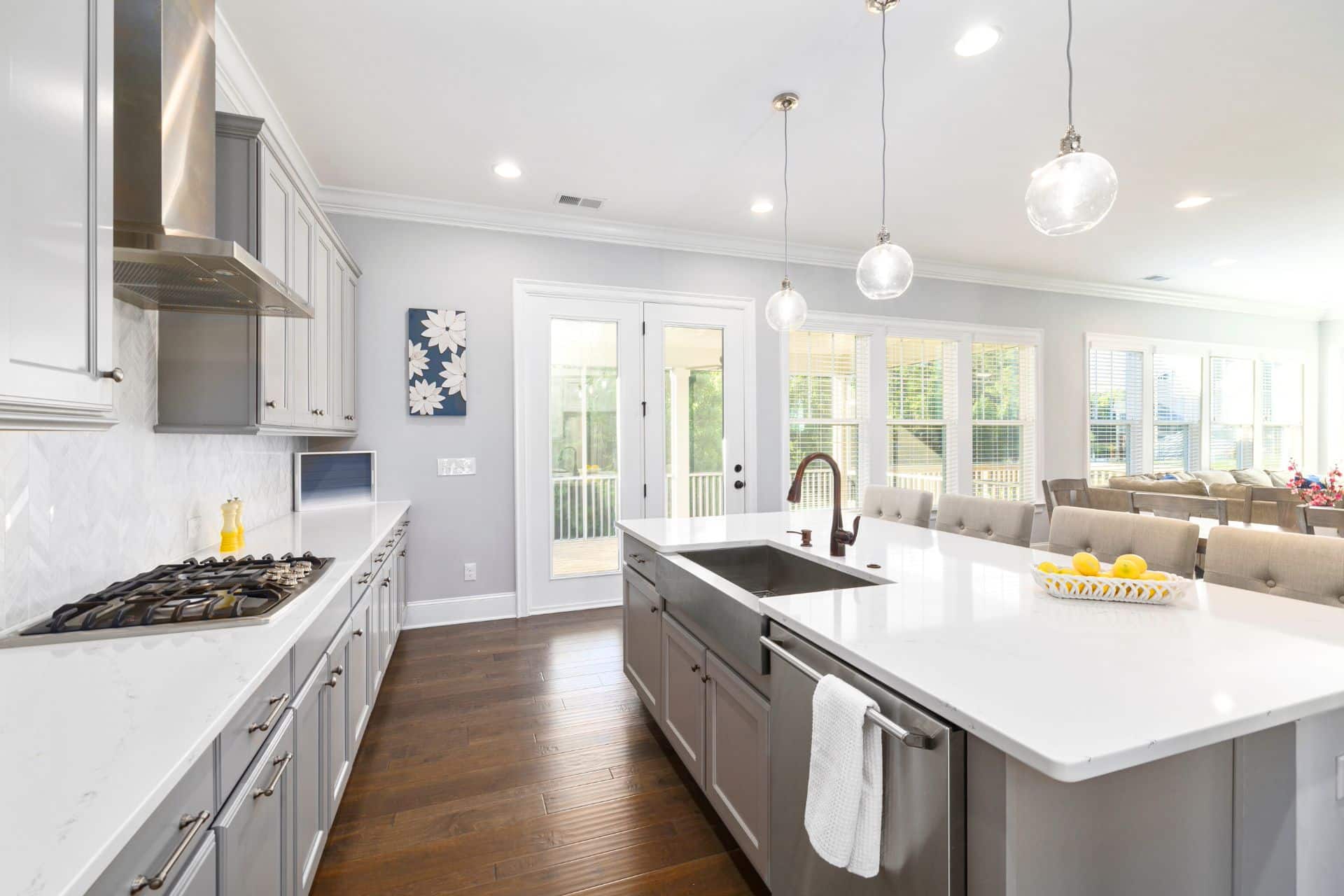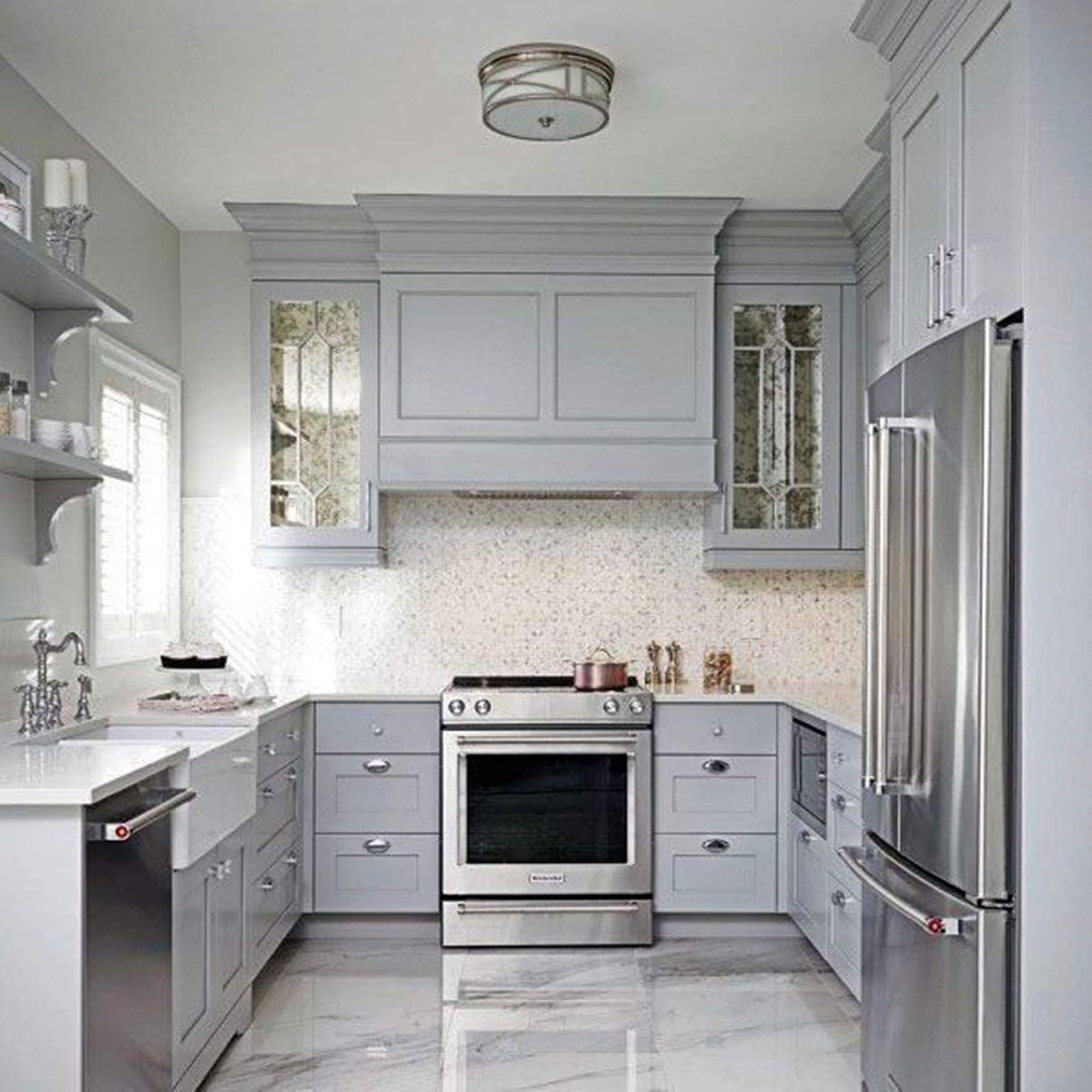Flooring Options that Complement White Cabinets

White cabinets offer a clean, versatile backdrop for a kitchen or bathroom, allowing for significant design flexibility in flooring choices. The right flooring can enhance the overall aesthetic, creating a cohesive and stylish space. Careful consideration of material, color, and texture is crucial to achieve the desired effect.
Popular Flooring Materials for White Cabinets, Flooring with white cabinets
Three popular flooring materials frequently paired with white cabinets are hardwood, tile, and laminate. Each offers unique advantages and disadvantages.
| Material | Durability | Maintenance | Cost | Style |
|---|---|---|---|---|
| Hardwood | High; resistant to scratches and dents with proper finish | Moderate; requires regular sweeping, occasional mopping, and refinishing over time | High | Classic, elegant; wide range of colors and finishes available |
| Tile (Ceramic or Porcelain) | Very High; extremely durable and resistant to water damage | Low; easy to clean and maintain | Medium to High | Modern, clean; available in various colors, patterns, and sizes |
| Laminate | Medium; susceptible to scratches and water damage | Low; easy to clean | Low to Medium | Versatile; mimics the look of hardwood, stone, or tile at a lower cost |
Wood Tone Choices for White Cabinets
The choice of wood tone significantly impacts the overall feel of the space. Light, medium, and dark wood tones each offer a distinct visual effect when paired with white cabinets.
Flooring with white cabinets – Light Wood Tones: Light wood tones, such as blonde oak or light maple, create a bright, airy atmosphere. Imagine a kitchen with crisp white cabinets and light oak flooring; the space feels open and inviting, perfect for smaller rooms. The light wood complements the white, preventing the room from feeling stark or cold.
Medium Wood Tones: Medium wood tones, like hickory or cherry, offer a warm and inviting feel. A kitchen with white cabinets and medium-toned hickory flooring provides a balance between lightness and warmth. The richer tones add depth and visual interest without overwhelming the white cabinets.
Dark Wood Tones: Dark wood tones, such as walnut or ebony, create a sophisticated and dramatic look. In a kitchen with white cabinets and dark walnut flooring, the contrast is striking and elegant. This combination works particularly well in larger spaces where the dark floor won’t make the room feel cramped.
Textured Flooring for Visual Interest
Textured flooring adds visual interest and depth to a kitchen with white cabinets. Distressed wood flooring, with its variations in color and texture, provides a rustic charm. Patterned tile, such as Moroccan or geometric designs, can add a bold statement.
Small Kitchens: In smaller kitchens, lighter colored, less busy textured flooring is recommended to avoid overwhelming the space. A lightly distressed light oak floor or small-scale patterned tile would be suitable choices.
Large Kitchens: Larger kitchens can handle more dramatic textural elements. Distressed dark wood floors or large-format patterned tiles can create a striking focal point, adding personality and character to the space.
Color Palettes and Design Styles with White Cabinets and Flooring

White cabinets offer remarkable versatility, serving as a neutral backdrop that complements a wide range of color palettes and design styles. The choice of flooring significantly impacts the overall aesthetic, influencing the mood and functionality of the kitchen. Careful consideration of color harmonies and design elements ensures a cohesive and visually appealing space.
Color Palettes and Flooring Material Combinations
Selecting the appropriate color palette and flooring material is crucial for achieving a harmonious kitchen design. The interplay between cabinet color, wall color, and flooring creates the overall ambiance. Three distinct color palettes, each paired with a suitable flooring material, are presented below to illustrate the possibilities.
- Grey-Blue Palette with Light Grey Hardwood Floors: This palette evokes a sense of calm and sophistication. The cool tones of grey-blue on the walls create a serene atmosphere, complemented by the subtle warmth of light grey hardwood floors. The white cabinets provide a clean contrast, preventing the space from feeling overly cool.
- Warm Beige Palette with Natural Stone Tiles: This palette creates a welcoming and inviting space. Warm beige walls and cabinetry create a sense of comfort, while natural stone tiles (such as travertine or limestone) add texture and visual interest. The combination of natural materials fosters a grounded and earthy feel.
- Black and White Palette with Polished Concrete Floors: This palette offers a modern and dramatic contrast. Black accents against the white cabinets and walls create a striking visual impact, while polished concrete floors add a sleek, industrial edge. This option is ideal for contemporary kitchen designs.
Kitchen Design Layouts
The following examples demonstrate how white cabinets can be incorporated into three distinct kitchen design styles, each with a contrasting flooring choice to emphasize the style’s characteristics.
- Modern Kitchen: A modern kitchen featuring white shaker cabinets could incorporate sleek, dark grey porcelain tiles. The clean lines of the cabinets are mirrored in the geometric precision of the tiles. Stainless steel appliances and minimalist countertops further enhance the modern aesthetic. The overall effect is one of streamlined elegance and sophisticated simplicity.
- Farmhouse Kitchen: A farmhouse kitchen utilizes white cabinets with a distressed finish to achieve a rustic charm. Wide-plank, light oak hardwood floors provide warmth and texture, complementing the natural wood elements often found in farmhouse designs. Open shelving, vintage-inspired hardware, and a large farmhouse sink further enhance the rustic aesthetic.
- Traditional Kitchen: A traditional kitchen might feature white raised-panel cabinets paired with dark stained hardwood floors. The rich, warm tones of the flooring provide a grounding contrast to the crisp white of the cabinets. Ornate crown molding, detailed backsplash, and antique-style lighting fixtures complete the traditional look, creating a sense of timeless elegance.
Impact of Warm-Toned vs. Cool-Toned Flooring
The choice between warm-toned and cool-toned flooring significantly influences the overall atmosphere of a kitchen with white cabinets.
- Warm-Toned Flooring: Warm-toned flooring, such as light oak or cherry hardwood, creates a welcoming and inviting atmosphere. The warm hues contribute to a feeling of coziness and comfort, making the space feel more intimate and inviting. This is particularly effective in kitchens that receive limited natural light.
- Cool-Toned Flooring: Cool-toned flooring, such as grey or white tile, provides a clean and modern aesthetic. The cool tones create a sense of spaciousness and airiness, making the kitchen feel larger and brighter. This is an excellent choice for kitchens with ample natural light or a desire for a more contemporary feel.
Practical Considerations and Maintenance: Flooring With White Cabinets

Selecting flooring for a kitchen, especially one with white cabinets, requires careful consideration of both aesthetics and practicality. High-traffic areas demand durable materials that can withstand daily wear and tear while maintaining their appearance. The choice of flooring significantly impacts the overall maintenance routine and longevity of the kitchen’s design.
Maintaining different flooring types in a high-traffic kitchen with white cabinets necessitates a tailored approach. Porous materials, like natural stone, require more frequent cleaning and sealing to prevent staining, while resilient options, such as vinyl or luxury vinyl plank, offer easier maintenance. Understanding the specific needs of your chosen flooring is crucial for preserving its beauty and extending its lifespan.
Cleaning Methods for Various Flooring Types
The cleaning method significantly impacts the longevity of your flooring. For example, hardwood floors benefit from regular sweeping or vacuuming to remove abrasive particles, followed by occasional damp mopping with a pH-neutral cleaner. Avoid excessive moisture, which can damage the wood. Ceramic or porcelain tiles, being more resistant to moisture, can tolerate more thorough cleaning, but grout lines require specific attention to prevent mold and mildew growth. Luxury vinyl plank flooring typically requires only sweeping or damp mopping, while natural stone may need specialized cleaners and sealants to maintain its luster and prevent staining.
Damage Prevention Strategies for Kitchen Flooring
Preventing damage is key to extending the life of your kitchen flooring. Placing mats at entryways can help trap dirt and debris, minimizing the abrasion of flooring materials. Using protective furniture pads under heavy appliances and furniture prevents scratching and indentation. Promptly cleaning spills avoids staining, especially on porous materials. Regular maintenance, including polishing hardwood floors or resealing natural stone, helps prevent damage and maintain the flooring’s appearance. Consider using felt pads under chairs and tables to minimize scratches on harder surfaces like tile or hardwood.
Step-by-Step Guide to Choosing Kitchen Flooring
Choosing the right flooring for a kitchen renovation involves a systematic approach.
- Define your budget: Establish a realistic budget encompassing material costs, installation, and potential future maintenance. Consider factoring in potential unexpected costs.
- Assess your lifestyle: Consider your family’s activity level and the frequency of spills and high-traffic areas. A family with young children or pets may require more durable and easy-to-clean flooring.
- Analyze existing décor: The flooring should complement the existing kitchen design, including cabinetry (in this case, white cabinets), countertops, and backsplash. Consider color palettes and design styles for cohesive aesthetic.
- Research flooring options: Explore various flooring materials, considering their durability, maintenance requirements, cost, and aesthetic appeal. Compare options such as hardwood, tile, vinyl, laminate, and natural stone.
- Obtain samples and test them: Order samples of your shortlisted flooring options to assess their appearance in your kitchen’s lighting and alongside your existing décor. Test their durability and water resistance.
- Get professional installation: Unless you possess extensive experience, hiring a professional installer ensures proper installation and prevents potential future issues.
Flooring Choices for White Kitchens (Rewritten)
White kitchens offer a clean, versatile backdrop for a range of flooring choices. The key is to select a flooring material that complements the brightness of the cabinets without overpowering the space. Hardwood floors, particularly those with lighter stains, create a classic, elegant look. Their warmth contrasts beautifully with the cool tones of white cabinets. However, hardwood requires regular maintenance and is susceptible to scratches and water damage. Ceramic or porcelain tiles offer durability and easy maintenance, making them a practical choice for high-traffic areas. A variety of colors and textures are available, allowing for customization. Luxury vinyl plank (LVP) provides a cost-effective alternative to hardwood, mimicking its appearance while offering superior water resistance and durability. Consider the overall style of your kitchen when making your selection. A modern kitchen might pair well with sleek, minimalist tiles, while a traditional kitchen might benefit from the warmth of hardwood or the rustic charm of natural stone. Ultimately, the best flooring choice depends on individual preferences, lifestyle, and budget.
